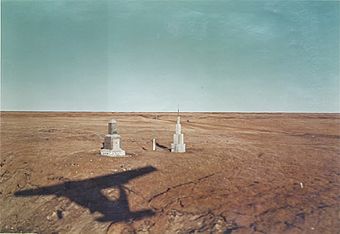Rogers-Post Site facts for kids
|
Rogers-Post Site
|
|
 |
|
| Location | Near Walakpa River mouth, about 11 miles (18 km) southwest of Utqiaġvik |
|---|---|
| Nearest city | Utqiaġvik, Alaska |
| Area | 0.5 acres (0.20 ha) |
| Built | 1935 |
| Architect | Will Rogers Memorial; Jesse Stubbs |
| NRHP reference No. | 80004564 |
Quick facts for kids Significant dates |
|
| Added to NRHP | April 22, 1980 |
The Rogers-Post Site is a special place in Alaska. It marks where a plane crash happened on August 15, 1935. This accident tragically killed two famous Americans: Will Rogers, a beloved humorist, and Wiley Post, a pioneering aviator. The site is located on the North Slope of Alaska, about 11 miles (18 km) southwest of Utqiaġvik.
Contents
A Tragic Flight in Alaska
In 1935, Will Rogers and Wiley Post were on an exciting aerial tour of Alaska. They were flying from Fairbanks to Barrow (now Utqiaġvik). As they flew, they ran into thick fog and could not see well.
The Crash Details
They found a small clear spot in the fog near Walakpa Bay. They decided to land there. They met some Alaska Natives and got directions for the short trip left to Barrow. When they took off again, their plane was only about 50 feet (15 meters) in the air. Suddenly, the engine stopped working. The aircraft crashed into the lagoon and flipped over. This was the first deadly plane crash near the city of Utqiaġvik.
Remembering Will Rogers and Wiley Post
The Rogers-Post Site is important because it honors these two famous people. Over the years, two monuments have been built there to remember them.
The First Monument
The first monument was built three years after the crash. People from all over the United States helped pay for it. It was designed in Oklahoma, which was the home state of both Rogers and Post. The monument was made from poured concrete. It looked like two cubes, with a smaller one on top of a larger one. A pink granite marker from near Rogers' home was placed on it.
The dedication ceremony for this monument was a big event. It was broadcast live on CBS radio. The broadcast connected four different places: Barrow, the United States Capitol, the Oklahoma State Capitol, and the Texas State Capitol.
The Second Monument
Fifteen years later, a second monument was built. This one was a concrete obelisk, which is a tall, slender, four-sided pillar. It was made of four blocks that got smaller as they went up. This monument was almost 10 feet (3 meters) taller than the first one.
A man named Jesse Stubbs, who was 72 years old at the time, built this second monument. He said he was a childhood friend of Will Rogers. Stubbs traveled all the way to Alaska to build it. This monument remembers not only Rogers and Post but also Alaskan veterans from World War II. Both monuments originally looked out over the lagoon where the plane crashed.
Moving the Monuments
Over time, the land around the site began to wear away because of coastal erosion. This meant the monuments were at risk. In 2016, the second monument, built by Jesse Stubbs, was moved to Utqiaġvik (Barrow) for safety. Photos from 2017 show that only the original monument still stands at the crash site.
A Historic Place
The Rogers-Post Site was officially added to the National Register of Historic Places in 1980. This listing helps protect the site and recognizes its importance in American history.


